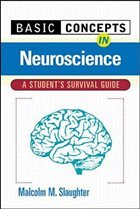Nicht lieferbar

Basic Concepts In Neuroscience: A Student's Survival Guide
Versandkostenfrei!
Nicht lieferbar
*A new book in the Basic Concepts series *Explains the fundamental principles of neuroscience and helps students organize and condense the material they need to study *Level of the material progressively builds from simple to complex, enabling mastery of concepts *Content is presented in simple, jargon-free language *Critical need-to-know information is highlights in boxes *Numerous tables and charts help compare and contrast key informationReview quote:This is an excellent choice for medical students, graduate students, and residents alike, as time may be a limiting factor when preparing for ...
*A new book in the Basic Concepts series *Explains the fundamental principles of neuroscience and helps students organize and condense the material they need to study *Level of the material progressively builds from simple to complex, enabling mastery of concepts *Content is presented in simple, jargon-free language *Critical need-to-know information is highlights in boxes *Numerous tables and charts help compare and contrast key information
Review quote:
This is an excellent choice for medical students, graduate students, and residents alike, as time may be a limiting factor when preparing for standardized tests in neuroscience.
Table of contents:
1. Anatomy of the Nervous System. 2. Cell Biology of the Nervous System. 3. Nervous System Cell Biology. 4. Neuronal Signaling. 5. Synaptic Transmission. 6. Neurotransmitters. 7. Sensory Signals. 8. Neural Control of Motor Activities. 9. Control of Rhythmic Activity. 10. Cortical Control of Movement. 11. Motion and Motivation: The Nigrostriatal and Limbic Systems. 12. Neuroplasticity: The Visual Cortex. 13. Memory Mechanisms. 14. Cognition. 15. Sleep and Wakefulness. 16. Viral Effects on the Nervous System.
A PROVEN METHOD FOR LEARNING THE MOST DIFFICULT-TO-UNDERSTAND CONCEPTS IN NEUROSCIENCE * Organizes and condenses the key topics in neuroscience * Eliminates rote memorization of complicated facts * Presents difficult concepts in understandable steps * Reinforces key concepts and definitions * Allows you to assess your individual competency level and study needs * Expedites learning with summary boxes, flowcharts, and diagrams that speed review and highlight key points FINALLY! A STUDY SYSTEM THAT SETS PRIORITIES, MINIMIZES MEMORIZATION, AND REDUCES STRESS! If you like this study method, try these other titles in the McGraw-Hill BASIC CONCEPTS series. Brown: BASIC CONCEPTS IN PATHOLOGY 0-07-008321-5 Clancy: BASIC CONCEPTS IN IMMUNOLOGY 0-07-011371-8 Sweeney: BASIC CONCEPTS IN EMBRYOLOGY 0-07-063308-8 McKenzie: BASIC CONCEPTS IN CELL BIOLOGY AND HISTOLOGY 0-07-036930-5 Gilbert: BASIC CONCEPTS IN BIOCHEMISTRY, 2nd edition 0-07-135657-6 Horwitz: BASIC CONCEPTS IN GENETICS 0-07-134500-0 Stringer: BASIC CONCEPTS IN PHARMACOLOGY, 2nd edition 0-07-135699-1 Seidel: BASIC CONCEPTS IN PHYSIOLOGY 0-07-135656-8
This book explains the fundamental principles in neuroscience and focuses on those concepts that students have identified as being most difficult to grasp. Beginning with an overview of the anatomy and cell biology of the nervous system, the text proceeds to neuronal signaling, neurotransmitters, control of activity and movement, memory, and cognition. The level of the material progressively builds from the simple to complex so that students can quickly learn the material and feel comfortable applying it.
Review quote:
This is an excellent choice for medical students, graduate students, and residents alike, as time may be a limiting factor when preparing for standardized tests in neuroscience.
Table of contents:
1. Anatomy of the Nervous System. 2. Cell Biology of the Nervous System. 3. Nervous System Cell Biology. 4. Neuronal Signaling. 5. Synaptic Transmission. 6. Neurotransmitters. 7. Sensory Signals. 8. Neural Control of Motor Activities. 9. Control of Rhythmic Activity. 10. Cortical Control of Movement. 11. Motion and Motivation: The Nigrostriatal and Limbic Systems. 12. Neuroplasticity: The Visual Cortex. 13. Memory Mechanisms. 14. Cognition. 15. Sleep and Wakefulness. 16. Viral Effects on the Nervous System.
A PROVEN METHOD FOR LEARNING THE MOST DIFFICULT-TO-UNDERSTAND CONCEPTS IN NEUROSCIENCE * Organizes and condenses the key topics in neuroscience * Eliminates rote memorization of complicated facts * Presents difficult concepts in understandable steps * Reinforces key concepts and definitions * Allows you to assess your individual competency level and study needs * Expedites learning with summary boxes, flowcharts, and diagrams that speed review and highlight key points FINALLY! A STUDY SYSTEM THAT SETS PRIORITIES, MINIMIZES MEMORIZATION, AND REDUCES STRESS! If you like this study method, try these other titles in the McGraw-Hill BASIC CONCEPTS series. Brown: BASIC CONCEPTS IN PATHOLOGY 0-07-008321-5 Clancy: BASIC CONCEPTS IN IMMUNOLOGY 0-07-011371-8 Sweeney: BASIC CONCEPTS IN EMBRYOLOGY 0-07-063308-8 McKenzie: BASIC CONCEPTS IN CELL BIOLOGY AND HISTOLOGY 0-07-036930-5 Gilbert: BASIC CONCEPTS IN BIOCHEMISTRY, 2nd edition 0-07-135657-6 Horwitz: BASIC CONCEPTS IN GENETICS 0-07-134500-0 Stringer: BASIC CONCEPTS IN PHARMACOLOGY, 2nd edition 0-07-135699-1 Seidel: BASIC CONCEPTS IN PHYSIOLOGY 0-07-135656-8
This book explains the fundamental principles in neuroscience and focuses on those concepts that students have identified as being most difficult to grasp. Beginning with an overview of the anatomy and cell biology of the nervous system, the text proceeds to neuronal signaling, neurotransmitters, control of activity and movement, memory, and cognition. The level of the material progressively builds from the simple to complex so that students can quickly learn the material and feel comfortable applying it.



